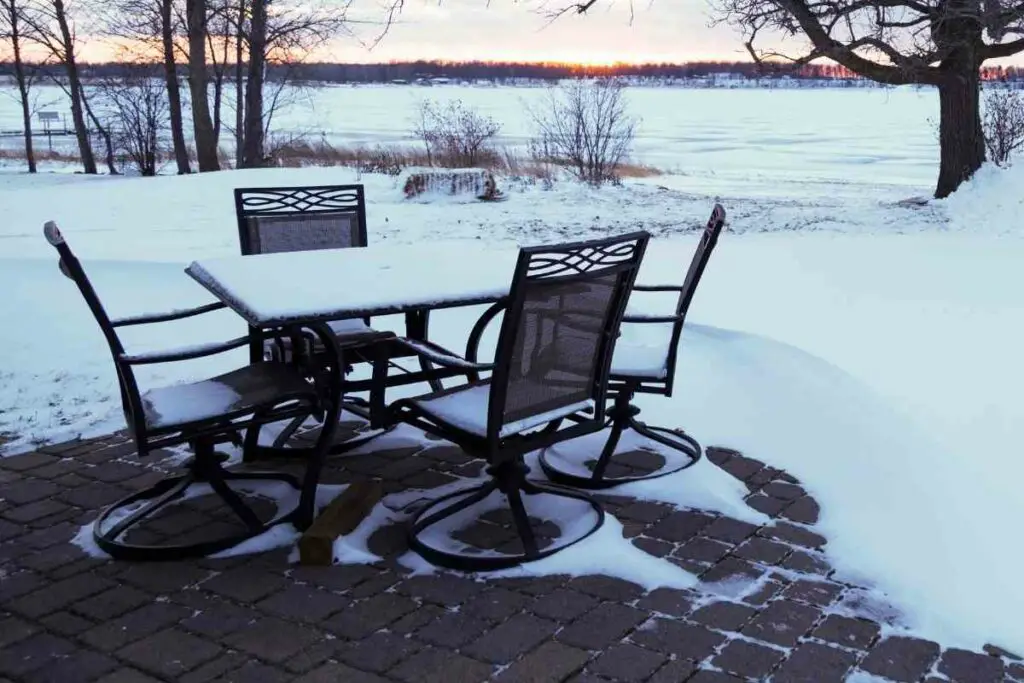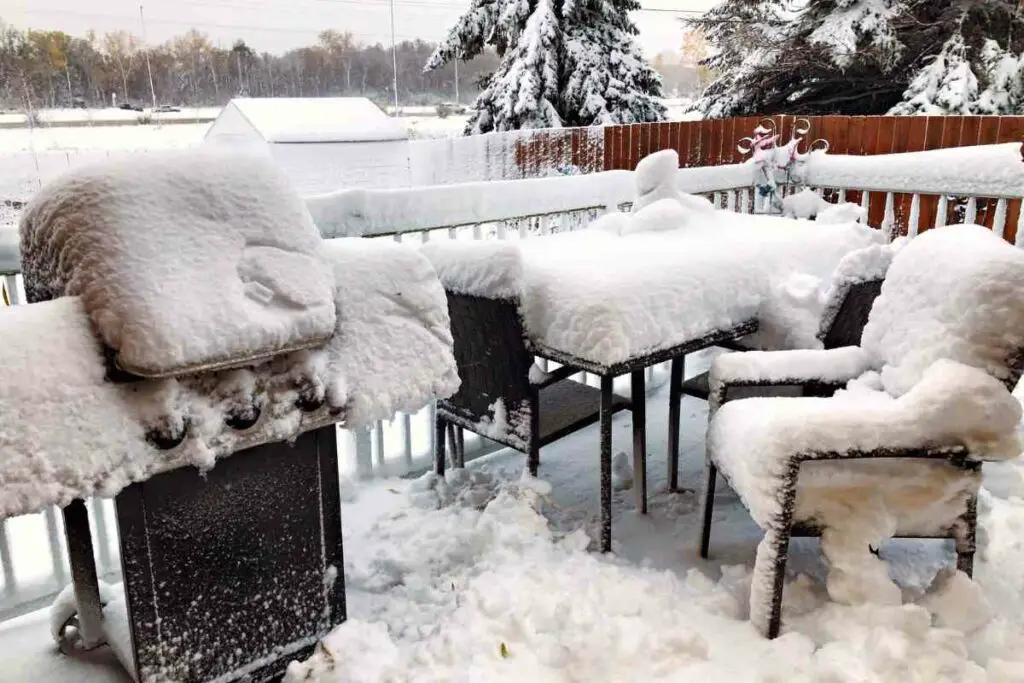Yes, you can leave your patio furniture outside in winter. This type of furniture comes with weatherproofing, making it possible to leave it out year-round. However, snow, rain, ice, and wind can still cause damage to your furniture.
You should take some precautions with your patio furniture when leaving it outside during the winter. That way, you won’t have to worry about it rotting or rusting.
Luckily, the steps you can take are simple and won’t take much time.

Table of Contents
Why Can I Leave Patio Furniture Outside During Winter?
Patio furniture isn’t the same as the furniture you keep inside your home. This type of furniture comes with some built-in weatherproofing. It should be able to resist some snow and rain.
However, it’s still good to take precautions. If you’ve had that outdoor furniture for a long time, the waterproofing seal could’ve worn off without you knowing it!
Do I Need To Cover Patio Furniture in Winter?
You’ll need to cover your patio furniture during the winter, especially if you have wooden pieces. The wood can absorb moisture, leading to cracking and rotting.
When it’s still dry outside, you’ll need to apply another coating of waterproof sealant to the furniture.
Once that dries fully, you can use a cover on the furniture. Most come with zippers or velcro to seal the furniture inside.
However, you can use a tarp and hold it down with bungee cords and get similar results.
Overall, it’s a good idea to cover your patio furniture during the winter. You don’t want your furniture to absorb water and freeze!
How Can I Winterize My Patio Furniture?
Winterizing your patio furniture won’t take long, so it’s good to make it into a habit.
Start by cleaning your furniture, then seal it with a coating of waterproof material. Many people do this in the spring every year.
If you have cushions, they’ll need a deep cleaning before winterizing them too. After cleaning and giving your items plenty of time to dry, you’re ready to move on to storing them.
However, every material requires something different.
Always Bring In Plastic Furniture
It’s worth noting that you should always store your plastic patio furniture inside, especially if you live in an area that has winters that drop below freezing frequently.
Plastic can get brittle and break when exposed to freezing temperatures for long periods. A tarp or cover won’t protect your plastic furniture from the cold.
Bringing it inside during the winter keeps the item from getting brittle.
Seal Your Wood Furniture
You must seal your wooden furniture before the winter each year. You can also take this opportunity to sand and repaint it.
It’s good to cover wood furniture with a tarp during the winter. Doing so can prevent it from absorbing some water- the new seal is essential to prevent it altogether.
Check Metal Furniture For Rust
Next, if you have any metal furniture, you’ll need to inspect it for rust before storing it.
Rust weakens the material and breaks it down. You can remove it by using a rust-removing primer or spray if you find rust.
If you cover the metal during winter, it’s sure to last you much longer without forming any rust.
Prices pulled from the Amazon Product Advertising API on:
Product prices and availability are accurate as of the date/time indicated and are subject to change. Any price and availability information displayed on [relevant Amazon Site(s), as applicable] at the time of purchase will apply to the purchase of this product.
Check Cushions For Mold
Your furniture’s cushions can quickly grow mold during storage. Luckily, you can prevent it by giving your pillows a deep clean before putting them away.
Vacuum the cushions, then spray them with a mixture of bleach, water, and laundry detergent.
The bleach should stop mold from growing. You don’t need a lot of it either! About one cup of bleach for every gallon of water is plenty.
Before covering the furniture, you will need to bring the cushions, and other fabrics, inside. The cushions are most prone to damage during the winter.
However, they should be small enough for you to find somewhere to store them indoors.
Finally, when you bring the cushions back out, make sure to inspect them for any mold again. You’ll want to clean them off before putting them back outside.

What’s the Easiest Way To Winterize Patio Furniture?
Many people use covers or tarps. It’s the easiest way to protect your belongings without moving them inside. The furniture must be dry before you cover it!
Any water left behind will stay trapped in the cover- leading to mold growth.
Another method is to move the patio furniture inside. You can easily store it in a garage or shed if you have the space. Keeping the cover on while the furniture is inside will keep it safe from dust.
While it can take a lot of strength to move your furniture, it’s usually for the best. There’s no way for your furniture to receive weather damage inside.
If you are not able to move the furniture indoors we recommend trying to build your own simple patio cover.
Can I Leave Wicker Patio Furniture Outside in Winter?
If you have wicker patio furniture, make sure to carry it inside before the winter season starts.
Water can freeze inside of the wicker material. The ice that forms can break the wicker easily. You should bring inside any wicker patio furniture you have.
Some types of wicker are more weather resistant than others. However, it’s still best to store it in your garage or shed.
Wicker furniture can be heavy, so you may want someone to help you bring them indoors. It’s safer to work with a partner to avoid muscle strain.
What Happens When Outdoor Furniture Gets Wet?
Your patio furniture is likely water-resistant, but that doesn’t mean that it’s fully waterproof.
Your furniture can get wet without breaking, but water damage can add up over time. Leaving your furniture uncovered causes more damage faster.
In short, snow and rain won’t ruin your furniture right away. It likely can get wet multiple times without any signs of damage.
Although, it’s best to prevent your furniture from getting wet when you can. Bring it inside or cover it before it rains. Find out how to protect your outdoor furniture from the rain.
- How to Build a Planter Box for Bamboo: A Step-by-Step Guide

- Can Robotic Lawnmowers Handle Steep Slopes?

- Do You Need a Specific Lawn for a Robotic Lawnmower? Expert Advice

- Are Robotic Lawnmowers Safe for Pets and Children? Safety Features of Robotic Lawnmowers

- Why Use Robotic Lawnmowers? Advantages of Using a Robotic Lawnmower

- Is the GARDENA SILENO City 300 Cordless or Corded? A Clear Answer















